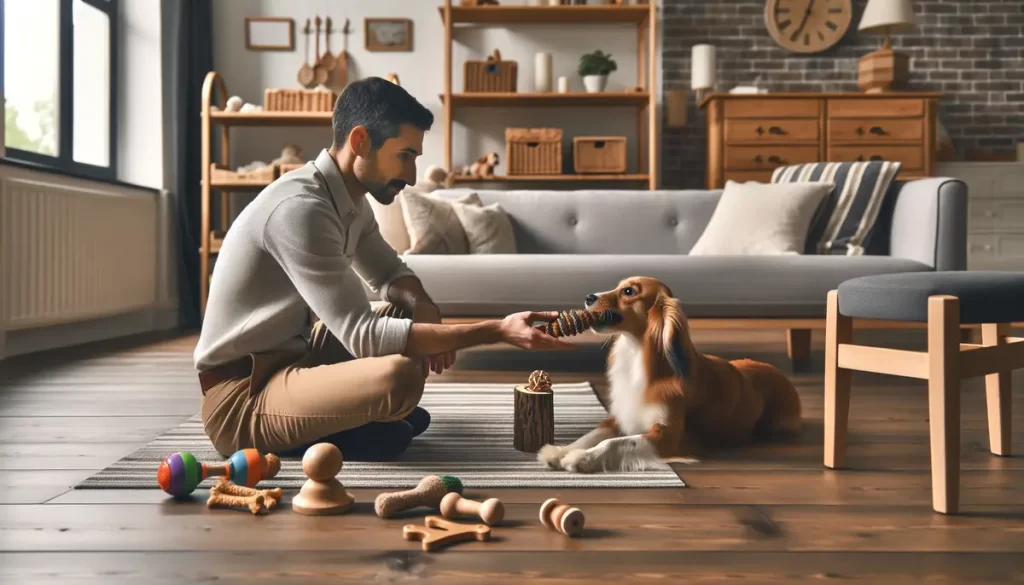Summary
Dogs chew wood due to anxiety, boredom, teething, or breed instincts. This habit is dangerous as it can cause splinters, internal blockages, and potential toxicity from treated wood. To stop wood chewing, remove access to wood, provide safe chew toys, and use bitter-tasting deterrent sprays. Ensure your dog gets enough exercise and mental stimulation to combat boredom. Address anxiety with a safe space and calming aids. Train commands like “leave it” and reward good behavior. Never punish your dog. Patience and consistency are key to breaking this potentially harmful habit.
Why Do Dogs Chew on Wood?
You might have observed your dog chewing on wood continuously out of nowhere. Well, in reality, this issue might not be out of “nowhere” because there are some reasons behind your dog’s confusing and problematic activity.
Chewing on any hard object may be a sign of your dog’s discomfort, which may include anxiety, boredom, and sometimes the reason for tooth pain.
By studying these reasons, you can solve this issue that bothers your loved furry friend as a responsible dog owner.
Reasons Why Your Dog Chews on the Wood
Don’t just assume that your dog is chewing wood for entertainment. There can be several psychological and physical reasons why your pet does so.
Your Dog Must be in an Anxious State
Being anxious makes even humans do some unexpected and sometimes destructive activities that may be self-destructive or damaging to the outer environment.
Dogs are no different. Anxiety enables them to do activities that help to calm them down or take their worries off of non-living things. But now, your question must be, “Why is my dog anxious?”
Like human beings, dogs also experience anxiety; separation anxiety is one of the most common anxieties in dogs that causes them to act this way. Some of the ways by which dogs can experience separation anxiety are:
- Moving into a New House or Neighborhood
- Staying away from your dog most of the time
- Not giving proper attention to your dog
Boredom
Dogs, one of the most extroverted animals, need a satisfactory amount of attention and playful time from their owner. Being bored is one of the most unwanted things dogs will ever experience.
Chewing on complex objects like wood can indicate that your dog needs physical movement and exercise. Of course, it is also one of their best time passes.
Dental Problems
Growing up is when babies adopt habits and have fun learning and discovering new things. Still, it is also true that every good thing has a side effect, and they eventually suffer from many issues related to their bodies.
Dental pain is one of those things that cause discomfort for babies. Puppies are the same as human babies; while their canines grow, their gums and teeth have a lot of pain. Because of this, they often chew on the wood to relieve the pain.
Breed Difference
Some dogs have a higher urge to chew, attack, and bite things because of their genital instincts. The breed of the dog has a significant effect on its behavior. Chewing wood is also how a dog tries out and feeds its breed instincts.
Regardless, this chewing of wood habit is problematic and not a good thing to remain okay. Chewing on wood, too, can be dangerous for your dog’s mouth and stomach, and of course, isn’t it bad for your furniture as well?
Why Stop a Dog from Chewing Wood?
Chewing on wood can be harmful to your dog. Why? After all, it’s just passing its time, chewing on something. It is not as small of an issue as it seems.
The fact that it will destroy your furniture and cost you is not enough to stop your dog. This chewing habit is hazardous for your dog’s mouth and gums since it chews on the wood and eventually turns it into sharp pieces.
These fragments will probably pierce the mouth, mostly the tongue and gums; they will travel straight to its abdominal cavity if it swallows the splinters.
They would eventually cause damage and infection to the intestine, esophagus, and throat. This will lead to a massively costly vet bill for you to keep your dog in an acceptable condition.
As said, “prevention is better than cure.” This Is not just a shallow saying; it is a fact that you, as a dog owner, should adopt and follow.
How to Stop a Dog from Chewing on Wood?
Chewing on wood is a habit of dogs, and it is quite challenging to get rid of. The continuous urge to attack wood, scratch it with its canines, and tear it apart is powerful.
Most dogs’ hyperactive and impatient nature makes it harder for them to get rid of this habit. But if given proper treatment and guidance, this toxic and problematic habit of theirs can be rooted out.
As a dog owner, here are some effective ways by which you can solve this problem:
Keep the Surroundings Free of Any Readily Accessible Pieces of Wood
Dogs often like to play in the backyard, gardens, or open areas with a lot of space. But these open and accessible spaces are filled with dry leaves, plastics, and the most notorious, wood pieces.
You must keep your backyard or garden clean if you are a dog owner. The dog must be controlled and away from any wooden pieces if taken outside.
Change Their Chewing Objects
Like babies, chew toys are one of the best ways dogs can relieve their canine pain and the urge to bite and chew. Chew toys are tight and will not quickly turn into fragments; they are not as harmful as wooden pieces.
Behavior Modification
Dogs can be impatient, ignorant, and hard to control at times. They might be too invested in chewing on harmful objects and need to realize how they can harm their bodies.
But you, as dog owners, should be responsible and stop our furry friends from committing to these activities. And talking of controlling, it is not very easy to maintain animals and, more specifically, dogs.
The behavior modification technique is one way to ensure that your dog listens to what you order it to do or not do. Making it learn and obey your orders such as “no,” ” stop,” and “Come” might help stop your dog from chewing on wood.
Don’t Let it Get Dull.
Dogs need continued interaction, physical stimulation, and activity, or they will be bored and adopt habits like chewing on wood or other harmful objects.
Keep it moving and busy exercising, playing, or engaging in brain activity. It might be a big help in stopping your dog from doing any unnecessary chewing.
Sprays to Keep the Dog Away from Wood
If the wood is bitter and disgusting in taste, your dog will not bother to chew on the wooden object. Sprays such as bitter apple spray or any other spray of a gruesome taste can help achieve your goal.
You can also not bother yourself and buy one. You can also make it home with apple cider vinegar and spray it all over the wooden object.
Create Barriers
Keeping your dog away from wood may be more complicated. The best way by which you can keep your dog away from a piece of wooden furniture or object is to create some barrier so that it doesn’t enter and continue its harmful habit again.
Chewing on wood is one of the best times for a dog, and it might not seem like a big deal at first, but it turns into a big deal as soon as you take your furry friend to the vet.
Chewing on wood can be for many reasons: anxiety, boredom, growing canines in puppies, dental issues, or their breed instincts. This chewing problem can cause significant issues for your dog’s stomach and mouth, eventually leading to extensive operations. And it doesn’t sound enjoyable.
As a dog owner, you might be thinking about ways to get rid of this issue. Well, you should know how to stop a dog from chewing on wood.
This most common doggy issue is hard to deal with but is not impossible to eliminate; with continuous efforts, you can and will keep your dog safe.


